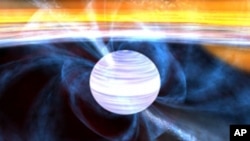Three citizen-scientists volunteering their personal computer time to a giant U.S. radio observatory have discovered a rare pulsar - an energetic young star that rotates dozens of times per second. The distant object was found among thousands of hours of data collected by the giant Arecibo Radio Telescope in Puerto Rico. Developers of the computer-sharing program are hopeful other unusual space objects will be found through this worldwide network of astronomy enthusiasts.
It is called Einstein@Home. Supported with grants from the National Science Foundation, the program harnesses the enormous processing power of tens of thousands of idle home computers, sifting through massive stores of data collected by Arecibo, the world's largest and most sensitive radio telescope.
An estimated quarter of a million volunteers in 192 countries have downloaded the free software to date, onto roughly half a million personal computers. The software quietly runs computations in the background, searching for unusual objects such as pulsars.
The newly-discovered pulsar - called J2007 - is a neutron star that spins on its axis 41 times per second. It's located in Vulpecula, a constellation 17,000 light years from Earth. One light year is the distance a beam of light travels in a year -about 9 and a half trillion kilometers.
Jim Cordes is head of the astronomy program at Cornell. Cordes says J2007 is unusual in that it does not have a companion star like most pulsars. "We think it came about from originally being in a binary system that is orbiting another star. Its evolution was influenced by the other star. And then the other star exploded as a supernova and the two stars went off in their own direction," he said.
J2007 was discovered by Chris and Helen Colvin of Ames, Iowa. The couple owns one of the two computers that spotted the pulsar among the mountains of Aricebo data in mid-June. The third person who discovered the Pulsar is Daniel Gebhardt, who lives in Germany.
Helen Colvin says both she and her husband work in the computer field but are not professional scientists.
Colvin says there were no flashing lights on their computer screen telling them they had discovered J2007, but they did receive an email from Bruce Allen, who directs the Einstein@Home to confirm their discovery. "The program itself doesn't indicate anything special about the data when it processes it. So, we actually found out about it from a letter," she said.
There are now more than a billion personal computers around the world sitting idle much of the time, according to Bruce Allen of the Center for Gravitation and Cosmology at the University of Wisconsin and the Max Planck Institute for Gravitational Physics in Germany.
Allen directs Einstein@Home. He says the data from Arecibo are divided into work units that are given a special number that's recorded in the database.
When a work unit is sent to a volunteer's computer, Allen says another number is entered into the database that uniquely identifies the computer receiving the data. And Allen says a third number identifies the results when they are sent back to the project for review. "So, we're not only able to say which volunteer did that particular piece of work, we also can identify which computer did it. We can even tell you to the second when the computer finished the computation," he said.
Allen says all discoveries are verified by a second home computer somewhere else in the world.
The software that runs Einstein@Home was developed by David Anderson of the University of California's Berkeley Space Sciences Laboratory. Anderson says the project's ultimate goal is to find neutron star pairs with orbits of an hour or less, so astronomers can actually observe Albert Einstein's theory of relativity in action.
A second major goal, says Anderson, is to find a pulsar orbiting a black hole, an object whose gravitational field is so strong, nothing can escape its pull, including light, and whose concentrated mass actually distorts the fabric of space and time. "A black hole is something like five or ten solar masses of material. We would love to monitor a pulsar and explore the space-time around a black hole. Obviously, those are rare objects but we have the potential of finding them in the Einstein@Home analysis," he said.
An article describing the discovery of a new pulsar by citizen scientists with the Einstein@Home program is published this week in the journal Science.
Citizen Scientists Discover Rare Pulsar Using Home Computers










